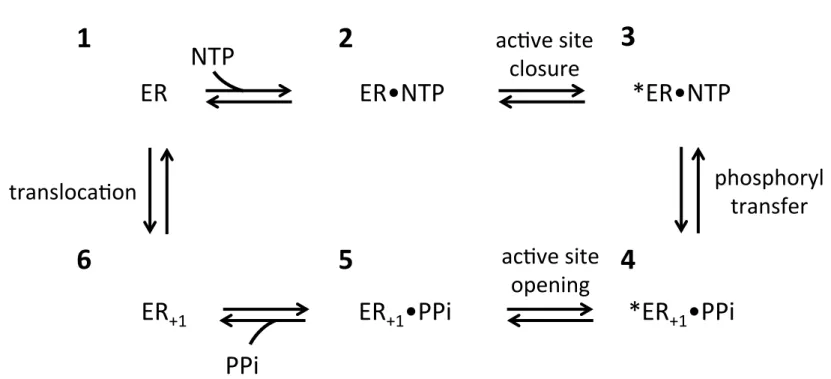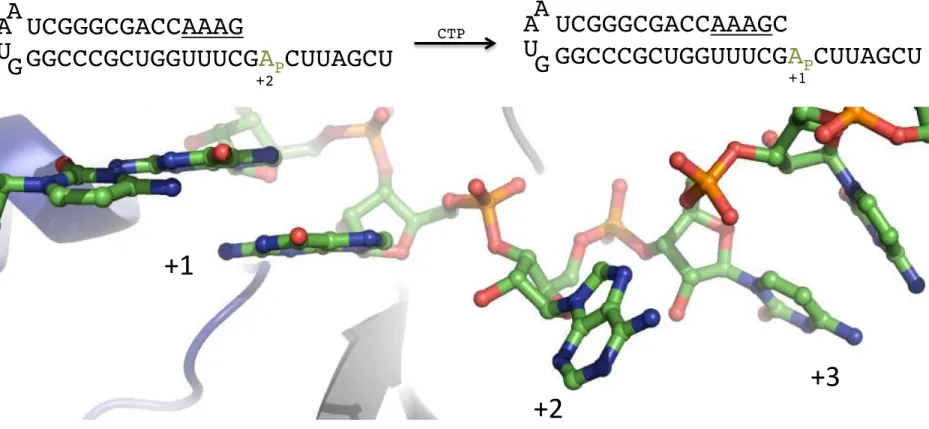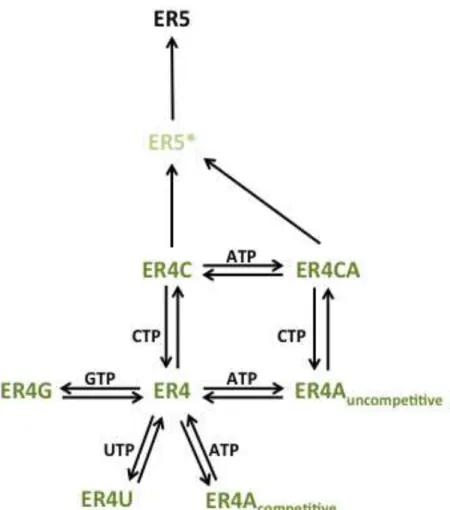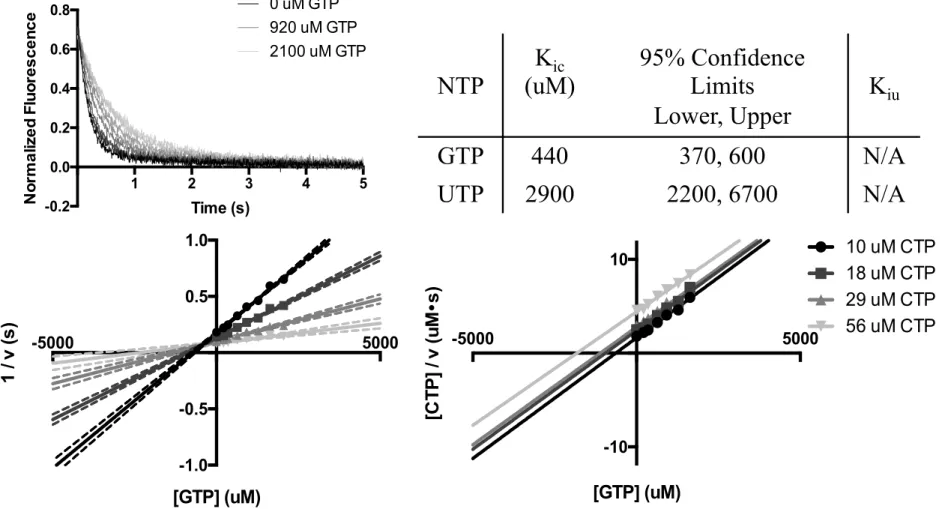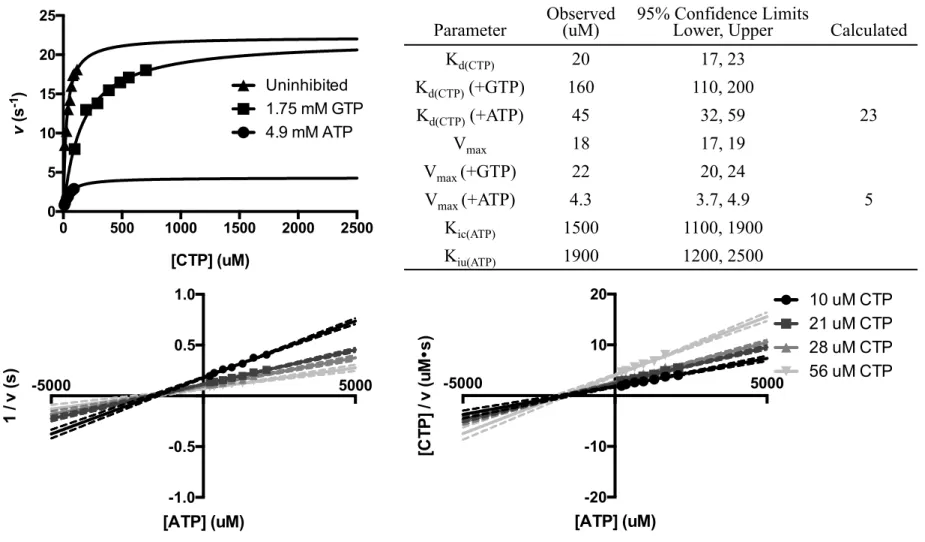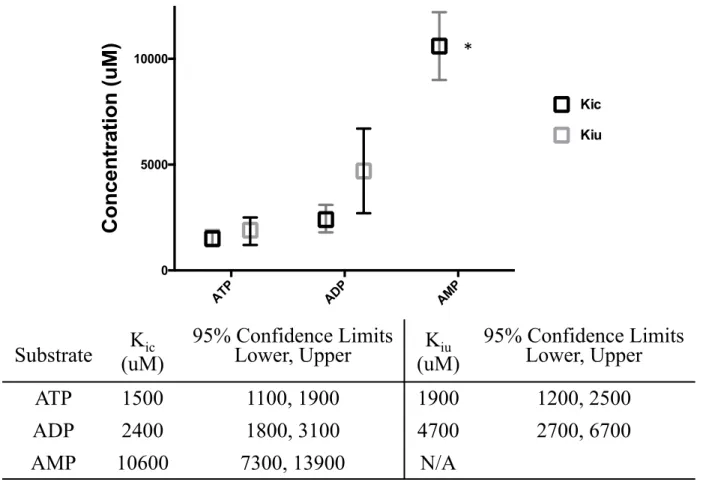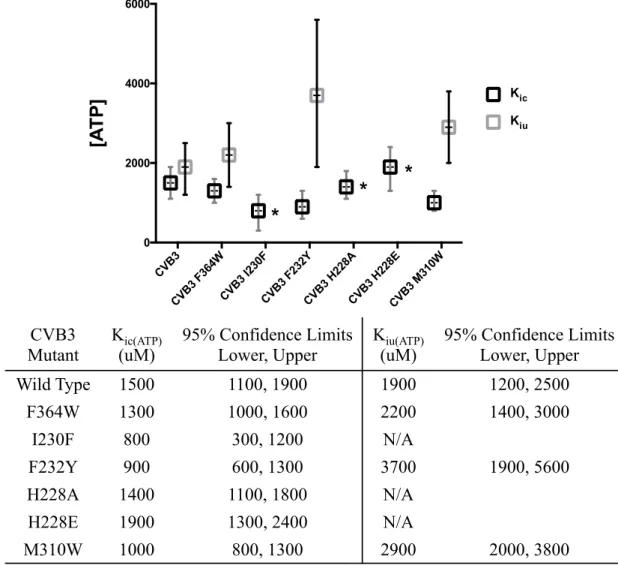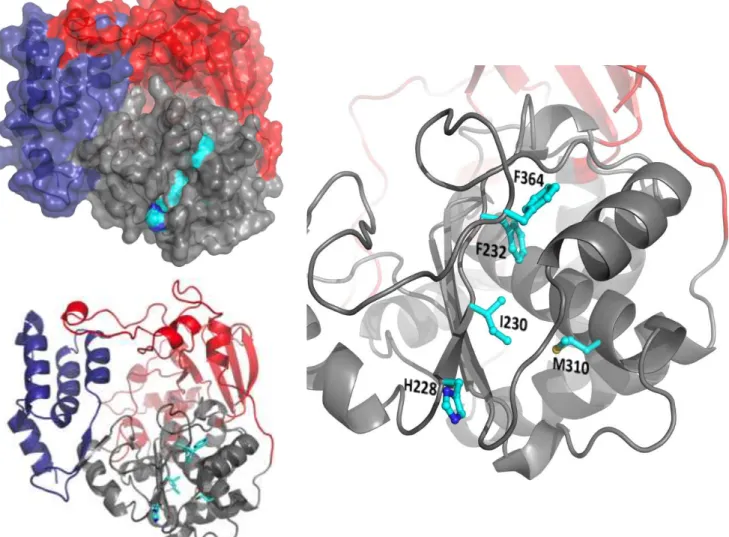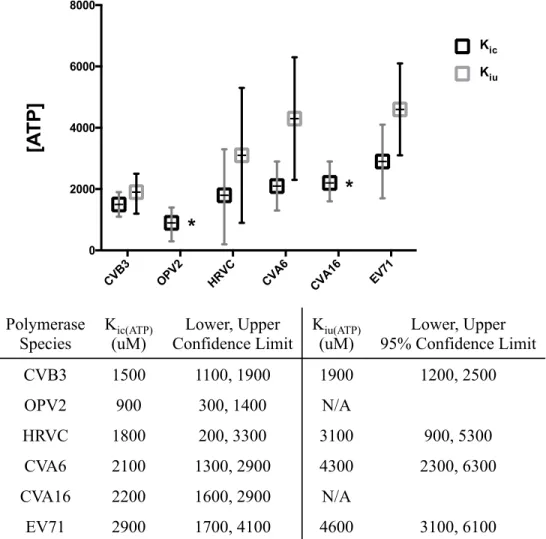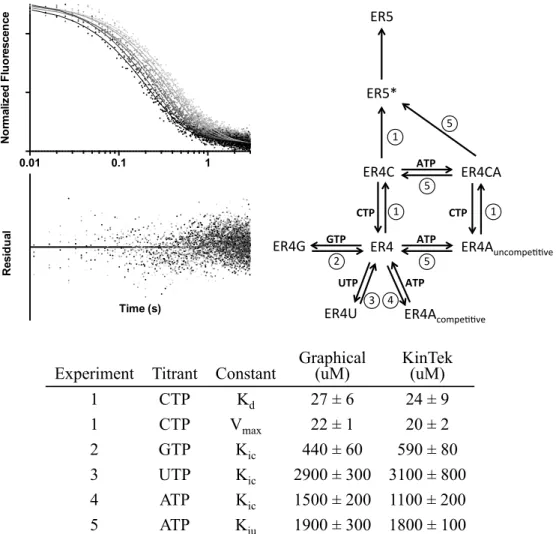THESIS
ADENOSINE TRIPHOSPHATE IS AN ALLOSTERIC INHIBITOR OF COXSACKIEVIRUS B3 3Dpol
Submitted by Jonathan Paul Karr
Department of Biochemistry and Molecular Biology
In partial fulfillment of the requirements For the Degree of Master of Science
Colorado State University Fort Collins, Colorado
Spring 2016
Master’s Committeee:
Advisor: Olve Peersen Robert Cohen
Copyright by Jonathan Paul Karr 2016 All Rights Reserved
ABSTRACT
ADENOSINE TRIPHOSPHATE IS AN ALLOSTERIC INHIBITOR OF COXSACKIEVIRUS B3 3Dpol
Picornaviruses pose a significant threat to human and animal health, but at present there are no drugs to prevent or treat picornaviral infections. However, intensive study of the picornaviral lifecycle has revealed several promising pharmacological targets, including the RNA-dependent RNA polymerase, 3Dpol, that is responsible for replicating the viral genome. 3Dpol is central in the virus lifecycle, determines the distribution of mutants in viral progeny, and is a very highly conserved protein across picornavirus species. As such, it is an attractive target for antiviral research. The only 3Dpol inhibitors that have been found to date are nucleoside analogues that act directly on the active site, even though global dynamics of the protein that are sensitive to allosteric effects of various mutations have been shown to be important determinants of fidelity. The research presented in this thesis provides the first direct evidence of allosteric regulation of 3Dpol by a small molecule. Inhibition assays investigating the relative affinities of a stalled coxsackievirus elongation complex for non-cognate nucleotides uncovered a mixed inhibition profile of ATP. Among the six picornavirus species tested, this mode of inhibition seems specific to coxsackievirus B3 (CVB3). Engineered mutations in CVB3 3Dpol, including two that were previously found to lower polymerase fidelity, diminish the uncompetitive component of ATP inhibition. ATP inhibition was found to be dependent on the β- and γ-phosphates. The potential role of ATP’s allosteric effect in the virus lifecycle as well as the importance of a biochemically confirmed allosteric site on the polymerase are discussed.
TABLE OF CONTENTS Abstract...ii List of Figures...v Chapter 1: Introduction 1.1 Picornavirus Background...1 1.2 3Dpol Overview...3
1.3 3Dpol Enzymatic Mechanism...4
1.4 Allostery in 3Dpol...8
Chapter 2: Kinetic Studies of NTP Inhibition of 3Dpol 2.1 Introduction...9
2.2 Materials and Methods...11
2.2.1 Mutagenesis, Protein Expression, Purification...11
2.2.2 Fluorescence...11 2.2.3 Complex Assembly...13 2.2.4 Stopped-Flow Experiments...13 2.2.5 Graphical Analysis...14 2.2.6 Kinetic Modeling...15 2.3 Results 2.3.1 Inhibition of CTP Incorporation by NTPs...17
2.3.2 ATP is a Mixed Inhibitor of CVB3 3Dpol...19
2.3.3 ATP Binding is Phosphate-Driven...19
2.3.4 ATP Uncompetitive Inhibition is Reduced in Motif A Mutants...19
2.3.5 The Mode of ATP Inhibition Varies across Picornaviral Species...25
2.3.6 Kinetic Modeling...25
2.4 Discussion 2.4.1 Competitive Inhibition...30
2.4.2 Mechanism of ATP Inhibition...31
2.4.3 Significance...33
Chapter 3: Potential Allosteric Sites on 3Dpol 3.1 Introduction 3.2 Materials and Methods 3.2.1 In Silico Search for Allosteric Pockets...36
3.2.2 ATP Docking...37
3.2.3 Crystallography... ...38
3.3 Results 3.3.1 Potential 3Dpol Allosteric Sites...38
3.3.2 ATP is Accommodated by the P-Site...44
3.3.3 Electron Density for ATP was not Observed...44
3.4 Discussion 3.4.1 The Importance of Allostery...47
3.4.2 Potential Sites Identified by Cavity Searches...48
3.4.3 The P-Site Seems the Most Promising...50
LIST OF FIGURES
Chapter 1
1.1 Six-state model of 3Dpol catalytic cycle...7
Chapter 2 2.1 Molecular basis of PETE 2AP fluorescence change...12
2.2 KinTek input model of NTP inhibition of CVB3 3Dpol...16
2.3 GTP and UTP are competitive inhibitors of CTP incorporation...18
2.4 ATP is a mixed inhibitor of CTP incorporation...20
2.5 Phosphate requirements of ATP inhibition...21
2.6 CVB3 mutant effects on ATP inhibition...23
2.7 Mutated residues in CVB3 3Dpol...24
2.8 Mode of ATP inhibition across picornaviral species...26
2.9 Kinetic modeling reproduces parameter values from graphical analysis...28
Chapter 3 3.1 Potential allosteric sites on 3Dpol from three species...39
3.2 Allosteric sites on HCV NS5B...41
3.3 Comparison of binding sites on NS5B and 3Dpol...42
3.4 Comparison of P-Sites on CVB3 and EV71 3Dpol...43
3.5 Comparison of FP-Sites on PV and EV71 3Dpol...45
3.6 Putative binding pocket can accommodate an ATP...46
Chapter 1
Introduction
1.1 Picornavirus Background
Viruses of the family Picornaviridae comprise an important class of pathogens that continues to take a major toll on human and animal health across the globe.1 Picornaviruses cause a large variety of diseases with diverse tissue tropism, from the common cold to poliomyelitis to foot-and-mouth-disease.2 Such diversity is achieved in spite of a small 7.5 to 10 kb genome,3 a proteome of only eight mature proteins, and a high level of antigenic conservation.4 Though their adaptability has made picornaviruses difficult to treat and eradicate, the conservation of certain viral proteins provides hope for broad-spectrum antivirals.5,6 Currently, however, no such antivirals exist, though there have been numerous but ultimately unsuccessful lead compounds targeting different points in the virus lifecycle, especially through inhibition of viral proteins.6
Upon infection of a host cell, the viral positive-sense single-stranded RNA (+ssRNA) genome is directly translated by host machinery into a polyprotein that undergoes proteolytic processing to yield structural and nonstructural proteins. The nonstructural 3D protein, dubbed 3Dpol, uses the +ssRNA molecule as a template to synthesize a negative strand intermediate that in turn serves as a template for positive strand synthesis. Early in infection, translation by host proteins is favored by default and mostly suppresses negative strand synthesis. As viral proteins accumulate, they interact with cloverleaf and IRES structures in the 5’-untranslated region of the +ssRNA to suppress translation and promote replication.7 3Dpol then amplifies the genome in
“replication factory” complexes that form on the surfaces of newly synthesized cytoplasmic membranes where replication components are concentrated and the double-stranded RNA intermediate is protected from innate immunity responses.8
Since 3Dpol is central to the replication of the genome, it is likely a crucial determinant of the kinetics of the viral lifecycle, especially in the early stages of infection when viral RNA is limiting. 3Dpol is also responsible for generating a distribution of mutant genotypes, named quasispecies, by virtue of its relatively low replication fidelity. Genetic diversity of virus populations allows fast adaptation to environmental pressures and is crucial for tissue tropism and pathogenicity. As a result, high-fidelity virus strains are attenuated.9,10 On the other hand, RNA viruses require a minimum genetic stability and are susceptible to “error catastrophe” if mutation rates exceed wild type rates significantly, causing low-fidelity mutants to also be attenuated.11,12 Hence, though mutation frequencies among RNA viruses are on the order of a million times higher than what is observed in eukaryotic DNA polymerases,13,14 they are at a delicate optimum for virulence.11,15 Modulators of 3Dpol fidelity therefore have the potential to attenuate picornaviruses.
Because of its central role in virus lifecycle as a fine-tuned determinant of viral fitness, 3Dpol has been the subject of much research in the last twenty years. A combination of biochemistry, molecular genetics, and structural biology has elucidated the mechanisms of 3Dpol function and fidelity.16 Concurrently, antivirals targeting the hepatitis C virus (HCV) RdRp, HIV reverse transcriptase, and herpes virus DNA polymerase have met with success, validating viral nucleic acid polymerases as antiviral targets.6,17,18 Hence, in the face of a total shortage of drugs against picornaviruses, 3Dpol should be intensely studied as a potential pharmacological target. After reviewing foregoing research on the polymerase, the work presented in this thesis will
elucidate a potential regulatory mechanism in a subset of picornaviruses that could inform design and discovery of allosteric inhibitors of 3Dpol.
1.2 3Dpol Overview
As reviewed by Ferrer-Orta et al., RdRps are structurally homologous to the three other families of nucleic acid polymerases: DNA-dependent DNA polymerases, DNA-dependent RNA polymerases, and reverse transcriptases.19 They share an overall fold described as a cupped right hand with palm, fingers, and thumb domains that form three important channels intersecting at the active site: the template entry channel, the NTP entry channel, and the product exit channel. However, RdRps are distinct in the structure of their active site. Whereas in the other classes of nucleotide polymerases flexibility of the fingers domain allows for dramatic swinging motions responsible for active site closure, the RdRp fingers domain makes inflexible contact with the thumb domain via an extended loop, permanently encircling the active site.20
Due to their “closed hand” configuration, RdRps have a different mechanism to structure the active site for catalysis. 3Dpol uses a hydrogen-bonding network between the 2’- and 3’-hydroxyls of the incoming nucleotide with palm-domain residues to trigger active site closure via structuring a three-stranded β-sheet in the palm domain.20 This positions two divalent cations coordinated by conserved aspartate residues in the palm domain proximal to the α-β phosphodiester-linkage of the incoming nucleotide, where they catalyze nucleophilic attack by the 3’-OH of the priming nucleotide. Catalysis requires the coordinated action of a conserved lysine in the palm domain to act as a general acid to protonate the pyrophosphate leaving group.21 Together these findings reveal an important feature of RdRps: recognition of the incoming nucleotide via interactions with its sugar and triphosphate moieties is coupled to active site closure and subsequent catalysis.20 That substrate recognition (quantitated as a Kd) and the
committed step of catalysis (limiting kcat) are one event facilitated by the coordinated motions of a single domain helps explain why speed and fidelity are negatively correlated in 3Dpol,22 because fast active site closure can compensate for weak binding per the catalytic efficiency (kspec=kcat/Kd). That discrimination depends on the orientation of the ribose hydroxyls explains the experimental convenience that in vitro discrimination factors for incorporating 2’-deoxy nucleotides are predictive of in vivo misincorporation rates.11,22
Owing to the palm domain’s central role in catalysis, it is unsurprising that it contains five of the eight conserved polymerase motifs (A-E)23 and that most known mutations of 3Dpol that modulate fidelity are within this domain.11,22,24 Unexpectedly, though, the two characterized mutations with the most dramatic effects on poliovirus 3Dpol fidelity, the high-fidelity G64S and low-fidelity H273R mutations, reside in the fingers domain more than 15 Å away from the active site.25 This implicates long-range interaction networks as important contributors to fidelity.26 Molecular dynamics and NMR studies have confirmed that global dynamics of 3Dpol determine the binding competency of the active site for incoming nucleotide and that dynamics of the palm domain depend on the correctness of the incoming nucleotide, directly affecting catalytic efficiency.27,25,28 It is also known that native packing of the N-terminus distal to the active site is necessary for elongation activity,29,30 providing additional evidence for a tight network of interactions collaborating throughout the polymerase to facilitate function.
1.3 3Dpol Enzymatic Mechanism
In order to understand and manipulate 3Dpol fidelity, the polymerase’s mechanism of catalysis has been thoroughly investigated from both biochemical and structural angles. These studies have elucidated the steps in the chemical cycle of 3Dpol as well as the key residues and
structural motifs whose coordinated actions facilitate its function. Together, their findings paint an almost complete picture of the mechanistic basis of polymerase fidelity.
The full catalytic cycle of poliovirus 3Dpol was biochemically characterized by Arnold and Cameron and was found to be highly similar to already known nucleic acid polymerase mechanisms.31 Beginning from an enzyme-RNA complex, the sequence of enzymatic events is binding of an NTP to form a ternary complex, a conformational change into a catalytically competent state, phosphoryl transfer (NMP incorporation), a second conformational change, and finally release of pyrophosphate to regenerate the original state. All steps up to and including catalysis were found to be isoenergetic, with both the first conformational change and phosphoryl transfer being partially rate-limiting. Post-catalysis, the RNA must translocate to move the next templating base adjacent to the active site. While the chemical assays used in this study were not sensitive to translocation per se, the authors suggest that the second conformational change is translocation because this step is essentially irreversible due to the large ΔG (-7.3 kcal/mol) driving it forward. Though pyrophosphate release was placed after translocation in their model, the authors note that a pre-translocation conformational change that allows pyrophosphate release could also explain the data.
Gong and Peersen complemented the biochemical approach with crystallographic studies.20,32 By crystallizing poliovirus elongation complexes, they were able to capture four distinct states that likely represent intermediates in the catalytic cycle, leading to a structural model in good agreement with the previous one. Before binding an NTP, the templating base is prepositioned in the active site and fully stacked on the upstream nucleotide. Upon binding, the incoming nucleotide base-pairs with the templating base and stacks on the priming nucleotide. It was observed that in the absence of either the 2’- or the 3’-hydroxyl on the NTP ribose, the NTP
could bind and cause subtle rearrangements in the fingers domain, but a catalytically competent state was not observed; rather, the triphosphate was 1 Å too distant from the active site, no divalent metals were coordinated, and the palm domain remained unstructured. In this state, the active site was said to be open. When the fully cognate nucleotide is present, motif A forms a three-stranded β-sheet with motif C, two Mg2+ ions are coordinated by Asp233, and the extensive hydrogen-bonding network between the palm domain and the ribose hydroxyls brings the triphosphate into close proximity to the catalytic residues. The authors dubbed this the closed conformation, which is catalytically active.
Interestingly, a post-catalysis relaxation back to the open state occurred without translocation, indicating that the two events are not necessarily coupled. This led to the addition of a sixth step in the catalytic cycle, a pre-translocation opening of the active site followed by release of pyrophosphate (see Figure 1.1). This allows for the possibility of pyrophosphate release being the trigger for translocation, which has been suggested as a general mechanism for polynucleotide polymerases.33 (For further discussion of translocation, see Section 3.4.2.)
Finding that palm domain dynamics are principally responsible for closing the active site inspired the design of numerous mutations in CVB3 3Dpol to attenuate viral replication.11,22 Virology studies showed that several palm domain mutants were stable and exhibited a mutator phenotype and that the in vivo mutation rates had a negative correlation with the polymerase’s ability to discriminate between 2’-deoxyCTP (dCTP) and CTP in vitro. Of these, the motif A mutants I230F and F232Y had the most dramatic phenotype and lowest discrimination factor. These two mutants did not have a significantly altered Kd for CTP, which is to say that they did not have a direct effect on nucleotide recognition. Rather, they had a faster maximum elongation rate by >20%, suggesting that active site closure rather than nucleotide binding is the fidelity
ER
ER•NTP
1
2
*ER•NTP
5
*ER
+1•PPi
3
ac.ve site
closure
ER
+1•PPi
phosphoryl
transfer
NTP
ac.ve site
opening
PPi
ER
+14
6
transloca.on
checkpoint these mutants bypass. Since the 230 and 232 residues are not in the active site, these mutations must decrease polymerase fidelity by disrupting the structure and dynamics of motif A and thereby indirectly impact catalytic efficiency. This provides further evidence that dynamic restructuring of the palm domain is needed for active site closure and that such dynamics are at least partly dictated by residues distant from the active site.
1.4 Allostery in 3Dpol
That polymerase dynamics, especially in the palm domain, play a role in determining polymerase fidelity provides hope for the development of allosteric regulators since allostery is known to work primarily through dynamic rather than static structural effects.34 Allosteric regulators of 3Dpol therefore have potential as prophylactics as well as therapeutics because they could attenuate picornaviruses by perturbing their delicate optimum between speed and fidelity.
Furthermore, allosteric regulators potentially avoid the shortcomings of the other class of 3Dpol inhibitors, nucleotide analogues. As discussed by Graci et al., the more direct strategy of using nucleotide analogues as chain terminators to arrest elongation or as mutagens to induce error catastrophe has encountered significant roadblocks.35 The first barrier to this class of compounds is delivery to the cytoplasm since phosphates prohibit transmembrane diffusion. Using nucleoside analogues (such as the adenine/guanosine analogue ribavirin) partially circumvents this problem since some have a limited ability to passively diffuse through membranes and many can enter through nucleoside transporters present on almost all cell types. However, the transporters’ specificity and size restraints restrict what substituents can be added to modify the drug. Once inside the cell, the nucleoside must be a substrate of multiple kinases to become a mutagenic NTP and at the same time avoid being a substrate for ribonucleotide reductases that could make it a mutagenic dNTP. Of course, it also must be a substrate for 3Dpol.
Finally, it must do all of the above without disrupting the exquisitely regulated nucleoside metabolism pathways, which could be the limiting factor of ribavirin’s usefulness.36 These difficulties with using nucleoside analogues as therapeutics underscore the usefulness of small-molecule allosteric regulators in modulating polymerase fidelity.
There is only one site on the surface of 3Dpol known to have allosteric properties. Interface I was identified in the first X-ray crystal structure of poliovirus 3Dpol as a contact between the thumb domain of one polymerase and the fingers domain of another. Because of its large surface area (1480 Å2 total) and very specific contacts, it was proposed to be a real and important interface, not just a crystallographic artifact.37 It has since been shown to mediate oligomerization of 3Dpol into membrane-associated arrays both in vitro and in vivo, potentially promoting RNA binding and elongation through allosteric effects.38,39 Additionally, disrupting Interface I has been shown to hamper the uridylation of the viral VPg protein that serves as a primer for RNA synthesis, perhaps through disrupting binding of 3CD to 3Dpol or through allosteric effects within 3Dpol itself.40,41 Interface I could therefore be a potential target for allosteric regulators, but because of its size it may be better fit for protein rather than small molecule ligands.
The research detailed in the following chapters uncovers a novel allosteric regulation of 3Dpol elongation by ATP at cellular concentrations. Mutations that disrupt this behavior are characterized and may indicate where on the polymerase ATP is binding. Additionally, computational methods are employed to identify potential allosteric sites. The potential role of ATP’s allosteric effect in the virus lifecycle as well as the importance of a confirmed allosteric site on the polymerase are discussed.
Chapter 2
Kinetic Studies of NTP Inhibition of 3Dpol
2.1 Introduction
In the context of a host cell, 3Dpol must discriminate between all four NTPs as it replicates the viral genome. Its fidelity is dictated by the efficiency with which it incorporates the cognate nucleotide over non-cognate nucleotides. This efficiency can be quantitated as the quotient of two kinetic parameters, the rate of incorporation (kcat) over the effective affinity for the nucleotide (!!
!""
). The relative affinities of the enzyme-RNA complex for the respective nucleotides are therefore a significant contributor to fidelity, and, along with corresponding rates of incorporation, dictate the rates of misincorporation and thus which misincorporations are more likely.42 Indeed, the competitive inhibitor constant (Kic), which describes the complex’s affinity for the inhibitor species, is equivalent to the Michaelis constant (Km) for that species as an alternate substrate.43 Hence, a mutant that differentially affects the polymerase’s affinities and incorporation rates for different nucleotides has the potential to modulate fidelity, not only in how many misincorporations are made but also in the frequencies at which different misincorporations occur. Measurement of inhibition constants could therefore be another in vitro tool to characterize fidelity.
The research presented in this chapter uses stopped-flow kinetics to probe the inhibitory effects of non-cognate NTPs on the incorporation of CTP in a fluorescent single-turnover system. Several picornaviral polymerases, including a series of engineered mutations in coxsackievirus B3 (CVB3) polymerase, are examined. Unexpectedly, ATP is found to be a
mixed inhibitor of CVB3 3Dpol. Further experiments as well as the analysis in the next chapter were performed in an effort to characterize the uncompetitive component of ATP inhibition, including attempts to locate its allosteric binding site on the polymerase surface.
2.2 Materials and Methods
2.2.1 Mutagenesis, Protein Expression, Purification
Site-directed mutagenesis was performed using the QuikChange protocol (Agilent, CA) and confirmed through sequencing by Genewiz, Inc. Protein constructs were expressed and purified as described previously in [44].
2.2.2 Fluorescence
Kinetic experiments employed a fluorescent RNA (see Figure 2.1), named a polymerase elongation template element (PETE), that recapitulates primer-template duplex and can facilitate polymerase elongation.44 After incorporation of a few nucleotides, the elongation complex (EC) stalls and remains very stable with a half-life of several hours. At saturating polymerase concentrations, this setup allows for essentially all the RNA in the system to be bound in the same state at a defined position along the PETE, depending on which nucleotides have been provided. Upon addition of the remaining nucleotide(s), reinitiation and elongation rapidly occur in a synchronized manner, resulting in an exponential fluorescence trace.
The fluorophore that was employed was 2-aminopurine (2AP), a fluorescent adenosine analogue that is highly sensitive to environmental changes, especially base-stacking, which quenches its fluorescence.45 Incorporating 2AP into the template strand of the PETE allows observation of translocation as the bases downstream of the active site undergo dramatic changes in base-stacking: the base in the +3 position is somewhat stacked on the +4 base, the +2 base is fully unstacked, and one face of the +1 base is stacked on the upstream duplex (Figure 2.1). As
FIG 2.1 Molecular basis of PETE 2AP fluorescence change. Above: Fluorescent PETE used in elongation assays showing where the polymerase stalls after incorporating AMP and GMP (underlined). Before CMP incorporation, the templating base in the +1 position is guanidine and 2-aminopurine (green) is in the +2 position. Incorporation of CMP and subsequent translocation move 2AP into the +1 position. Below: Elongation complex structure showing the extent of stacking in the base positions immediately downstream of duplex RNA (PDB: 4K4Y).
+1
+2
+3
UCGGGCGACCAAAG
GGCCCGCUGGUUUCG
A
PCUUAGCU
A
A
U
G
+2 CTPUCGGGCGACCAAAGC
GGCCCGCUGGUUUCG
A
PCUUAGCU
A
A
U
G
+1 122AP moves through these positions, there is first a large increase in fluorescence (+3 → +2) and then an even larger decrease (+2 → +1). By mixing complex with nucleotides in a rapid-mixing stopped-flow instrument, kinetic parameters can be extracted from 2AP fluorescence traces. It should be noted that, in this system, kpol is an apparent rate since it includes multiple steps and reports on the rate-limiting step, which is most likely active site closure and not catalysis.22 Since this is a single-turnover experiment, the hyperbolic dependence of rate on substrate concentration is an apparent Kd, not a Km.46
2.2.3 Elongation Complex Assembly
Elongation complexes were assembled at final concentrations of 30 µM 3Dpol, 10 µM PETE RNA, 112 mM NaCl, 2 mM HEPES pH 7, 4 mM MgCl2, 5 mM TCEP. 60 µM each of ATP and GTP was added and the reaction was incubated for 30 minutes at room temperature to pause the complex with a templating guanosine in the +1 position and 2AP in the maximally fluorescent +2 position (see Figure 2.1). This reaction was then diluted 200-fold in reaction buffer (75 mM NaCl, 2 mM HEPES pH 7, 4 mM MgCl2) and used in stopped-flow experiments at a final EC concentration of 12.5 nM.
2.2.4 Stopped-Flow Experiments
All solutions used in stopped-flow experiments were in reaction buffer. All NTP solutions were prepared with MgCl2 so that the Mg2+ concentration was always in 4 mM excess over final NTP concentration. Elongation reactions were carried out in a Bio-Logic SFM-4000 titrating stopped-flow instrument with an MOS-500 spectrometer at 30oC. Fluorescence excitation was at 313 nm with a 10 nm bandwidth and emission was detected using a 370/36 nm band pass filter.
2.2.5 Graphical Analysis
Fluorescence traces were fit to either a double exponential (! + !!!!!! !
+! !!!!!
! ) or double exponential with a linear (! + !!!!!!
! +!
!!!!! !
+ !!!) using Kaleidagraph (Synergy Software). The rate of the dominant exponential was used in subsequent linear plots.
Calculations of inhibition constants were made using Dixon and Cornish-Bowden linearization plots.47,48 Both analyses are based on the Michaelis-Menten equation, which in its expanded form is:
(1)
where v is the rate, Vmax is the limiting rate, Km is the Michaelis constant, Kic is the competitive inhibitor constant, Kiu is the uncompetitive inhibitor constant, s is substrate concentration, and i is inhibitor concentration. More specifically, to avoid the hyperbolic nature of the Michaelis-Menten equation, both analyses use the inverse of (1):
(2)
The Dixon analysis plots the inverse rate versus inhibitor concentration, which rearranges (2) to the following:
(3)
In this case, two lines representing experiments conducted with different substrate concentrations satisfy the following at the point of their intersection:
(4) + + + = iu ic m K i s K i K s V v 1 1 max + + + = iu ic m K i V s K i V K v s 1 1 max max + + + = iu ic m K i V K i s V K v 1 1 1 1 max max + = + ic ic K i s K i s 1 1 1 1 2 1 14
They can therefore intersect only when s1 = s2 or i = -Kic. Hence, the point of intersection between different lines on a Dixon plot gives the numeric value of Kic, regardless of the uncompetitive term. If the lines are parallel in this plot then no competitive inhibition is present.
The Cornish-Bowden analysis complements that of Dixon by plotting substrate concentration over rate versus inhibitor concentration as suggested by (2). It is easily shown that the intersection of two lines of different substrate concentrations on this plot must satisfy:
(5)
where the competitive term falls out and the x-coordinate of the point of intersection is equal to the numeric value of -Kiu. If the lines are parallel in this plot, then no uncompetitive inhibition is present. By using both plots, the mode of inhibition can be clearly diagnosed and the inhibition constants that reflect inhibitor binding constants can be calculated.
Inhibitor constants were calculated by performing a global fit in Graphpad Prism 6.0 (La Jolla, CA) in which all linear fits were constrained to share a common x,y coordinate pair that reflects the intersection point.
2.2.6 Kinetic Modeling
The overall model that was input to fit stopped-flow datasets is schematized in Figure 2.2. The center species, ER4, represents the enzyme-RNA complex that has stalled after four NMP incorporation steps. At this point, all four NTPs compete for the active site, with CTP-binding being the lone productive pathway. All NTP on-rates were assumed to be equivalent while their off-rates were allowed to vary. Both before and after CTP binding, ATP can bind uncompetitively to the allosteric site, resulting in a doubly liganded ER4CA complex that has a reduced rate of CTP incorporation. Catalysis and translocation result in an intermediate (ER5*) that then relaxes to another stalled complex (ER5). This intermediate step was needed to
+ = + iu iu K i s K i s 1 1 2 1
FIG 2.2 KinTek input model of NTP inhibition of CVB3 3Dpol. The vertical path
from the enzyme-RNA complex after the 4 preparatory incorporations, the ER4 species, models catalysis as a three-step process beginning with binding CTP, followed by incorporation and translocation, and then a relaxation event. All ER4 species are colored green to represent their high fluorescence. ER5* has a 10-fold dimmer fluorescence and ER5 has no fluorescence. Double arrows indicate equilibria, single arrows irreversible events.
accommodate a linear tail in the data (see below). Both catalysis and relaxation are assumed irreversible on the time-scale of these experiments (≤10 seconds).
The single-incorporation fluorescence traces observed in this system are best fit to a double exponential plus a linear component, with the amplitude of the first exponential approximately ten times that of the second. Therefore, the model included three sets of observables: all ER4 complexes, ER5*, and ER5, with the relative fluorescences at a ratio of 10:1:0 respectively. Total fluorescence was allowed to vary between experiments.
2.3 Results
2.3.1 Inhibition of CTP Incorporation by NTPs
To quantitate inhibition of CTP incorporation by non-cognate NTPs in CVB3 3Dpol, stopped-flow experiments were conducted in which inhibitors were titrated from ~200 uM to ~2 mM against 3-4 constant CTP concentrations near Kd(CTP). Quenching of 2AP fluorescence upon addition of CTP results in an exponential curve whose rate is dictated by a pseudo first-order rate constant kpol. Slowing of kpol by an inhibitor can be clearly seen when the fluorescence traces from a titration experiment are plotted against time on a normalized axis (Figure 2.3). An additional exponential term and sometimes a linear term were needed to accurately fit the curves using regression analysis, but since their respective rates did not titrate with inhibitor concentration, they did not factor into the analysis.
Inverse rates as a function of inhibitor concentration were plotted on the single-reciprocal Dixon and Cornish-Bowden plots (Figure 2.3). A series of four titrations against different CTP concentrations showed a clear point of intersection for GTP on the Dixon plot with a Kic(GTP) of 440 uM, which is on order with the physiological concentration of GTP of 300 uM.49 That the titration lines were parallel in the Cornish-Bowden plot indicates there was no uncompetitive
FIG 2.3 GTP and UTP are competitive inhibitors of CTP incorporation. Upper left: Representative fluorescence traces from a GTP titration against a constant CTP concentration. Lower panel: Dixon (left) and Cornish-Bowden (right) plots of GTP titrations against four CTP concentrations. Dashed lines represent 95% confidence intervals from fitting the intersection. Upper right: Results of global fitting analysis of the single reciprocal plots.
NTP
K
ic(uM)
95% Confidence
Limits
Lower, Upper
K
iuGTP
440
370, 600
N/A
UTP
2900
2200, 6700
N/A
1 2 3 4 5 -0.2 0.0 0.2 0.4 0.6 0.8 Time (s) No rma li z e d F lu o re s c e n c e 0 uM GTP 920 uM GTP 2100 uM GTP -5000 5000 -1.0 -0.5 0.5 1.0 [GTP] (uM) 1 / v (s)GTP Dixon Plot
-5000 5000 -10 10 [GTP] (uM) [C T P ] / v (u M • s)GTP Cornish-Bowden Plot
10 uM CTP 18 uM CTP 29 uM CTP 56 uM CTP 18inhibition term. A similar analysis of UTP showed purely competitive inhibition with a Kic(UTP) of 2.9 mM, which is about ten-fold higher than physiological concentrations of UTP of 250 uM.49
2.3.2 ATP is a Mixed Inhibitor of CVB3 3Dpol
Titration experiments with ATP as the inhibitor revealed a unique inhibition profile. Michaelis-Menten plots showed significant inhibitory effects by ATP on both kpol and Kd(CTP) (Figure 2.4), suggesting that ATP is not a purely competitive inhibitor. The Dixon plot of four ATP titrations gave a Kic(ATP) of 1.5 mM and the Cornish-Bowden plot showed a clear intercept at [ATP] = -1.9 mM, indicating that ATP is a mixed inhibitor of CVB3 3Dpol. Both Kic(ATP) and Kiu(ATP) are a little below the estimated physiological ATP concentration of 2.1 mM.49
2.3.3 ATP Inhibition is Phosphate-Driven
To parse which components of ATP are necessary for its inhibitory effects, titration experiments were performed with ADP and AMP (Figure 2.5). ADP had a mixed inhibition profile, with competitive and uncompetitive inhibition constants significantly reduced compared to ATP. Interestingly, the effect on Kiu was greater than that on Kic. AMP competitive inhibition was six-fold weaker than that of ATP, with an even weaker uncompetitive component. These results indicate that allosteric ATP binding to the polymerase depends largely on the triphosphate moiety, especially the β-phosphate, without which inhibition is essentially abolished.
2.3.4 ATP Uncompetitive Inhibition is Reduced in Motif A Mutants
Polymerase mutants with known fidelity effects were employed in kinetic experiments to test for altered inhibition by ATP and GTP (since there was not strong inhibition by UTP, it was not used in subsequent experiments). Motif A mutants I230F and F232Y were previously found to have significantly reduced fidelity and increased kpol.22 Neither had a significantly different
FIG 2.4 ATP is a mixed inhibitor of CTP incorporation. Upper left: Michaelis-Menten plots of CTP incorporation in the presence and absence of inhibitors. Lower panel: Dixon (left) and Cornish-Bowden (right) plots of ATP titrations against four CTP concentrations. Dashed lines represent 95% confidence intervals from fitting the intersection. Upper right: Numeric values of kinetic parameters from graphical analysis. Calculated values of Vmax and Kd(CTP) at 4900 uM ATP are derived from Kic(ATP) and Kiu(ATP).
Parameter
Observed (uM)
95% Confidence Limits
Lower, Upper Calculated
Kd(CTP) 20 17, 23 Kd(CTP) (+GTP) 160 110, 200 Kd(CTP) (+ATP) 45 32, 59 23 Vmax 18 17, 19 Vmax (+GTP) 22 20, 24 Vmax (+ATP) 4.3 3.7, 4.9 5 Kic(ATP) 1500 1100, 1900 Kiu(ATP) 1900 1200, 2500 -5000 5000 -1.0 -0.5 0.5 1.0 [ATP] (uM) 1 / v (s) -5000 5000 -20 -10 10 20 [ATP] (uM) [C T P ] / v (u M • s) 10 uM CTP 21 uM CTP 28 uM CTP 56 uM CTP 0 500 1000 1500 2000 2500 0 5 10 15 20 25 [CTP] (uM) v ( s -1) Uninhibited 1.75 mM GTP 4.9 mM ATP 20
Substrate
(uM)
K
ic95% Confidence Limits
Lower, Upper
(uM)
K
iu95% Confidence Limits
Lower, Upper
ATP
1500
1100, 1900
1900
1200, 2500
ADP
2400
1800, 3100
4700
2700, 6700
AMP
10600
7300, 13900
N/A
ATP ADP AMP
0 5000 10000
Concentration (uM)
Kic Kiu *FIG 2.5 Phosphate requirements of ATP inhibition. Results of Dixon/Cornish-Bowden analysis of adenylate inhibition of CVB3 3Dpol. For AMP, there was not a
well constrained fit for an intersection on the Cornish-Bowden plot, which is indicated by * in the graph and N/A in the table.
Kic(GTP) (data not shown), but both had an almost two-fold reduction in Kic(ATP) and a significant increase in Kiu(ATP) (Figure 2.6). This indicates that ATP uncompetitive inhibition was weakened or even abolished (in the case of I230F) in these mutants, while competitive inhibition by GTP was unaffected and Kiu(ATP) was reduced almost two-fold.
Since the side chains of I230 and F232 form part of a crevice that was identified as a candidate for being a ligand binding pocket (see Section 3.4.2), it was hypothesized that the allosteric site for ATP binding involved motif A and the effect of these mutations was to perturb ATP binding directly. A close analysis of the putative binding pocket shows that it is largely composed of peptide backbone and is therefore difficult to mutate (Figure 2.7). Surface-exposed histidine 228 forms the outer boundary of the pocket and due to its minimal interactions with other residues seemed a good candidate for mutagenesis that would perturb ligand binding without dramatic effects on local packing. Two mutant polymerases, H228A and H228E, were made and found to be active. Neither had a well-defined Kiu(ATP), but both had Kic(ATP) values comparable to that of wild type 3Dpol (Figure 2.6).
To further assess the importance of this pocket in ATP binding, a less direct mutation, M310W, was made beneath the surface of the pocket (Figure 2.7). A tryptophan in this position would not directly alter the geometry of the pocket, but could cause local rearrangements that would likely interfere with ATP binding. A stable and active M310W polymerase was purified and used in elongation assays. The mutation was found to attenuate ATP uncompetitive inhibition about 50%, with milder effects on Kic(GTP) and Kic(ATP) (Figure 2.6).
Another proximal residue, phenylalanine 364, whose peptide backbone forms part of the rim of the putative binding pocket, has been found to be an important residue for fidelity (McDonald et al., submitted). An F364W mutant strain was found to be stable in vivo with an
CVB3
CVB3 F364WCVB3 I230FCVB3 F232YCVB3 H228ACVB3 H228ECVB3 M310W
0 2000 4000 6000 ATP Inhibition [A TP] Kic Kiu
*
*
*
FIG 2.6 CVB3 mutant effects on ATP inhibition. ATP inhibition against six CVB3 mutants was evaluated by Dixon/Cornish-Bowden analysis. For I230F, H228A, and H228E, there was not a well constrained fit for an intersection on the Cornish-Bowden plot, which is indicated by * in the graph and N/A in the table.
CVB3 Mutant Kic(ATP) (uM) 95% Confidence Limits Lower, Upper Kiu(ATP) (uM) 95% Confidence Limits Lower, Upper Wild Type 1500 1100, 1900 1900 1200, 2500 F364W 1300 1000, 1600 2200 1400, 3000 I230F 800 300, 1200 N/A F232Y 900 600, 1300 3700 1900, 5600 H228A 1400 1100, 1800 N/A H228E 1900 1300, 2400 N/A M310W 1000 800, 1300 2900 2000, 3800
FIG 2.7 Mutated residues in CVB3 3Dpol. The polymerase is colored according to domains (red=fingers, grey=palm,
blue=thumb). Residues that were mutated are colored according to atom type (cyan=carbon, blue=nitrogen, yellow=sulfur). Upper left: Surface representation of 3Dpol highlighting the position and depth of the pocket formed in
part by the residues that were mutated. Lower left: Cartoon representation of the structure above with ball-and-stick representations of the side chains of the five residues of interest. Right: Close-up view of the mutated region.
increased replication fidelity phenotype. When used in inhibition assays, this mutant did not deviate significantly from wild type in any of the kinetic parameters (Figure 2.6).
2.3.5 The Mode of ATP Inhibition Varies across Picornaviral Species
From what is currently known of 3Dpol diversity among picornaviruses, coxsackievirus and poliovirus are at opposite poles of the speed and fidelity spectrum, with poliovirus polymerase being the fastest and most error-prone.22 Since the above motif A mutants lowered CVB3 3Dpol fidelity and increased its speed, pushing it toward the polio end of the spectrum, and also had a greatly reduced uncompetitive component of ATP inhibition, we hypothesized that ATP would have less of an effect on poliovirus polymerase. Indeed, Sabin strain OPV2 3Dpol was found to have Kic(GTP) and Kic(ATP) values comparable to CVB3, but a Kiu(ATP) could not be fit, indicating there is no significant uncompetitive component of ATP inhibition on this polymerase (Figure 2.8).
To determine how general mixed ATP inhibition is within Picornaviridae, four additional species were tested: two coxsackie type A species, CVA6 and CVA16, enterovirus 71 (EV71), and human rhinovirus C (HRVC). All four species had comparable competitive inhibition constants for GTP, though their Kic(ATP) values varied modestly (Figure 2.8). Other than HRVC, however, there was not clear indication of uncompetitive inhibition for any of these polymerases. In this regard, these species are more similar to poliovirus, with HRVC being intermediate. It would seem that the uncompetitive inhibitory effect of ATP on elongation is mostly specific to CVB3.
2.3.6 Kinetic Modeling
In order to corroborate the graphical analysis, kinetic simulation was performed using the computer program Global Kinetic Explorer (KinTek).50,51 KinTek uses a discrete differential
FIG 2.8 Mode of ATP inhibition across picornavirus species. ATP inhibition against
six species of 3Dpol was evaluated by Dixon/Cornish-Bowden analysis. For OPV2 and
CVA16, there was not a well constrained fit for an intersection on the Cornish-Bowden plot, which is indicated by * in the graph and N/A in the table.
Polymerase Species Kic(ATP) (uM) Lower, Upper Confidence Limit Kiu(ATP) (uM) Lower, Upper 95% Confidence Limit CVB3 1500 1100, 1900 1900 1200, 2500 OPV2 900 300, 1400 N/A HRVC 1800 200, 3300 3100 900, 5300 CVA6 2100 1300, 2900 4300 2300, 6300 CVA16 2200 1600, 2900 N/A EV71 2900 1700, 4100 4600 3100, 6100
CVB3 OPV2 HRVC CVA6 CVA16 EV71
0 2000 4000 6000 8000 [A TP] ATP Inhibition Kic Kiu
*
*
26equation solver to fit a user-defined model to experimental data. Once fed a dataset or multiple datasets along with initial conditions and information about which chemical species are observable, KinTek fits rate and non-rate parameters to the given model by minimizing χ2. A major advantage of KinTek is that it can handle very complicated models and give rigorous error estimates of fitted parameters. The user defines which parameters are fixed and which can vary. Very conveniently, ratios of parameters can also be fixed, allowing for equilibrium constants to be inputted even without knowledge of the on- and off-rates.
The overall model that was input to fit stopped-flow datasets is schematized in Figure 2.2. The center species, ER4, represents the enzyme-RNA complex that has stalled after four incorporations because of the absence of CTP (see Figure 2.1). At this point, all four NTPs compete for the active site, CTP-binding alone being the productive pathway. All NTP on-rates were assumed to be equivalent while their off-rates were allowed to vary. Both before and after CTP binding, ATP can bind uncompetitively to the allosteric site, resulting in a singly liganded ER4A or a doubly liganded ER4CA complex that has a reduced rate of CTP incorporation. Catalysis results in an intermediate (ER5*) that then relaxes to another stalled complex (ER5). Both catalysis and relaxation are assumed irreversible on the time-scale of these experiments (≤ 10 seconds).
The first experiment submitted for fitting was an eight-point titration of CTP from 12 to 120 µM with no inhibitors present. By global fitting of the model to all eight datatraces, Vmax and Kd(CTP) were determined and were in good agreement with values from the previous graphical analysis (Figure 2.9). These values were then fixed for the rest of the experiments. In the second experiment, a GTP titration from 200 to 2000 uM against 10 µM CTP was globally fitted to obtain a Kic(GTP) of 540 ± 80 uM, which was also within error of the value obtained from the
FIG 2.9 Kinetic modeling reproduces parameter values from graphical analysis. (Upper
left) A representative KinTek fit of an ATP titration on a log timescale, with the residual plot
below. (Upper right) The model from Figure 2.2 showing which experiment yielded the given parameter by numbering the equilibria according to the table below. The table lists the results from Michaelis-Menten and Dixon/Cornish-Bowden analyses alongside the values from the KinTek model (± standard deviation).
Experiment Titrant Constant
Graphical (uM) KinTek (uM) 1 CTP Kd 27 ± 6 24 ± 9 1 CTP Vmax 22 ± 1 20 ± 2 2 GTP Kic 440 ± 60 590 ± 80 3 UTP Kic 2900 ± 300 3100 ± 800 4 ATP Kic 1500 ± 200 1100 ± 200 5 ATP Kiu 1900 ± 300 1800 ± 100 !"#$ !"#$ %"#$ !"#$ !"#%&'()*+,--.,$ &"#$ !"#%()*+,--.,$ !"#/$ !"#0$ !"#$ &"#$ !"#0%$ !"12$ !"1$ '"#$ !"#3$ 4$ 4$ 5$ 6$ #$ 1$ 1$ 1$ 4$ 0.01 0.1 1 No rm a li z e d F lu o re s c e n c e Time (s) Re s id u a l 28
Dixon plot. Third, a UTP titration from 200 to 2000 µM also yielded a value in good agreement with the Dixon analysis, albeit with a large error since the titration was well below Kic(UTP).
Fitting Kic(ATP) and Kiu(ATP) required two different experiments and additional assumptions. It was assumed that ATP- and CTP-binding did not affect each other; the only effect of uncompetitive ATP binding was to produce ER4CA, which had a reduced rate for CTP incorporation as compared to the uninhibited ER4C species. An ATP titration against constant CTP had a well-constrained Kic(ATP) but a poorly constrained Kiu(ATP), whereas a CTP titration against a high concentration of ATP was just the reverse. So in the fourth experiment, Kic(ATP) was determined first by a titration of ATP from 200 to 2000 µM against 10 uM CTP without any uncompetitive pathway. This value was then fixed, and in the fifth experiment Kiu(ATP) was determined by fitting a CTP titration from 50 to 500 µM against 4.8 mM ATP. Neither inhibition constant was appreciably different from the graphical analysis results. The rate of ER4CA going to ER5* was 5.5 ± 0.2, a roughly 4-fold reduction in catalytic rate.
A major advantage of kinetic simulation, especially the dynamic simulation KinTek uses in which the model instantaneously updates as parameters are varied, is the ability to judge which parameters are well constrained by the data.46,50 For example, if two parameters are highly covariant and poorly constrained, i.e. one can compensate for the other, their confidence intervals fail to converge and large changes in their values have little effect on the overall goodness of fit by visual inspection or χ2 analysis. This provides useful information about redundancy in the model and also serves as a test of how well the molecular events in the experimental system are understood. Even minor (≤ 2-fold) changes of the fitted values for the parameters described here caused the model to obviously deviate from the data. Additionally, no
two parameters had equivalent effects on the model, nor could the model compensate if any were omitted, which suggests that the mechanism was not over-parameterized.
2.4 Discussion
2.4.1 Competitive Inhibition
Unlike other classes of single-subunit polymerases, which use swinging motions in the fingers domain to move the incoming nucleotide and templating base into the active site after they have paired, RdRps have a fully prepositioned templating base in the active site, thereby coupling nucleotide discrimination with active site closure.20 This implies that, in the cellular context, all four nucleotides are in direct competition for the active site and that fidelity depends greatly upon the polymerase’s sensitivity to the geometry of the nucleotide. This sensitivity has been shown to be largely mediated by motions of motif A in response to a hydrogen-bond network between the palm domain and the ribose hydroxyl groups. As might therefore be expected, motif A mutants that lower fidelity also have a reduced ability to discriminate between CTP and 2’-deoxyCTP, though they do not significantly alter the affinity for CTP. This raised the question of whether these mutants only altered the dynamics of active site closure or also increased the affinity of the polymerase for non-cognate nucleotides. The inhibition experiments described here provide a tractable way to directly investigate the effects of fidelity mutants on this affinity.
The competitive inhibition constants for GTP and ATP roughly scale with their physiological concentrations for all species investigated, whereas Kic(UTP) in CVB3 3Dpol is tenfold higher than its estimated cellular concentration. This is surprising since the templating base in this system is guanidine, with which uridine can base-pair better than the purines. One possible explanation for this may be the stronger pi-stacking interactions the purines can form
with the priming guanidine.52 An alternative explanation could be that to compensate for a faster kcat of UMP misincorporation, the polymerase has evolved a way to lower its affinity for UTP. Without determining kcat, however, this remains speculation. It is interesting that the purine Kic values are near their physiological concentrations, as this indicates that in the cell the polymerase could have significantly slower kinetics than what is suggested by studies in which only the cognate nucleotide is present. It also suggests that non-cognate nucleotides are by no means excluded from the active site, but rather occupy an appreciable portion of active sites at any given time.
The initial hypothesis that fidelity mutants may alter polymerase affinities for non-cognate nucleotides has been largely negated. Kic(GTP) hovers around 400 uM for all CVB3 mutants and also for the other species investigated, including poliovirus, which is known to have much lower fidelity than CVB3. Kic(ATP) varied more significantly among the polymerases, with almost 2-fold decreases in CVB3 I230F and F232Y as well as in poliovirus. However, as discussed below, Kic(ATP) values in CVB3 may be influenced by the uncompetitive component of ATP inhibition, making it more difficult to say whether the actual affinity of the active site for ATP is altered by these mutations.
2.4.2 Mechanism of ATP Inhibition
The Dixon and Cornish-Bowden analysis unambiguously identifies ATP as a mixed inhibitor of CVB3 3Dpol. An interesting consequence of the uncompetitive component of its inhibition is that ATP must bind an allosteric site on the enzyme. Allosteric regulation of nucleic acid polymerases by NTPs is not without precedent. Transcription initiation by E. coli RNA polymerase at a T7 A1 promoters has been shown to be allosterically inhibited by UTP.53 ATP was also found to be a mixed inhibitor of HIV-1 reverse transcriptase elongation.54 The hepatitis
C RdRp, NS5B, is stimulated by high concentrations of GTP.55 GTP bound at a low affinity site on the surface has been observed in a crystal structure of NS5B.56 Though mutational analysis indicates the GTP binding site in the crystal structure is not responsible for the observed stimulation in vitro, the site is important for replication in vivo.57 Additionally, several allosteric inhibitors of NS5B bind near the GTP binding site.58
Beyond the implication of allostery, the data give other hints at the mechanism of ATP inhibition. The relatively small difference between Kic(ATP) and Kiu(ATP) (400 uM) means that their effects on !!(!"#)
!""
should roughly cancel per the mixed inhibition equation !! !""
= !! (1 + [!]/!!" )/(1 + [!]/!!"), but the Michaelis-Menten analysis shows a much larger than predicted effect (Figure 2.4). This may result from the fact that unlike classic mixed inhibition, in which the inhibitor is thought to bind only one site and produce a catalytically incompetent species, ATP is bound both in the active site and in an allosteric site. Not only so, we hypothesize that the allosterically bound ATP may not produce a catalytically inactive species but, rather, a species that has a reduced rate of CTP incorporation, especially since incorporating such a rate was required for the kinetic simulation. In this case, Kic and Kiu as determined by graphical analysis do not represent true binding constants since the events which they dictate are not “dead ends” but rather have flux across them (i.e. from ER4Auncompetitive and ER4C to ER4CA to ER5) and are therefore not at equilibrium.43 This may explain why in the I230F and F232Y mutants, in which uncompetitive inhibition was eliminated, the Kic value decreased, which might reveal the “true” Kic value for ATP competing for the active site and reconcile the Michaelis-Menten analysis with the Dixon/Cornish-Bowden result.
This mechanism is akin to hyperbolic inhibition, so named because the enzymatic rate approaches a non-zero value as inhibitor concentration goes to infinity due to an active
inhibitor-substrate complex, causing the single reciprocal plot to look hyperbolic instead of linear at high inhibitor concentrations.43 Though such curvature is not present in the Dixon and Cornish-Bowden plots, because of practical considerations (such as solubility, cost, Mg2+ concentration and ion effects, and a desire to stay within physiologically relevant concentrations), the concentration of ATP was only taken as high as ~2 mM, resulting in a predicted saturation of ~50%, which may be too low to manifest a hyperbolic tendency.
2.4.3 Significance
Regardless of the precise mechanism of ATP inhibition, its mixed profile is important for two reasons. First, the presence of an allosteric site, especially one that is amenable to biochemical assays by virtue of its effect on in vitro elongation, has important implications for drug discovery, as evidenced by the inhibitors that bind the GTP allosteric site on NS5B. This will be the subject of further investigation and discussion in Chapter 3.
Second, a regulatory relationship between 3Dpol and ATP has implications for polymerase function and host-virus interactions. The fact that ATP slows the polymerase is interesting in light of the fact that speed and fidelity are negatively correlated in 3Dpol.22 This may imply that ATP maintains viral RNA replication in a higher fidelity state. This is supported by the observation that ATP uncompetitive inhibition is abolished in the two low-fidelity, high-speed motif A mutants, I230F and F232Y, whereas it is at wild-type levels in the high fidelity motif D mutant, F364W.
In an attempt to measure ATP effects on fidelity, 2’-deoxyCTP discrimination assays were performed in the presence and absence of ATP (data not shown). Unfortunately and for unknown reasons, the experiments failed to yield consistent effects on !!
!""
values, but the observed reductions in kpol were consistently proportional for both CTP and dCTP incorporation.
This argues that ATP inhibition does not contribute to 2’ OH based nucleotide discrimination, though due to the complex nature of ATP inhibition, the ratio of efficiency constants from this discrimination assay may not be a good measure of fidelity. Additionally, in vivo mutation rates of motif D mutants are not as well correlated with in vitro discrimination constants as they are for motif A mutants (McDonald et al., submitted). The putative binding pocket suggested by the mutagenesis studies (see Figure 2.7) is at the interface between motifs A and D, which may leave room for the possibility that ATP affects fidelity. To determine real mutation rates, in vitro replication of genome-sized fragments in the presence and absence of high ATP concentrations and subsequent sequencing analysis would be necessary.
A possible biological implication of these findings occurs to us based on the fact that, of the nucleotides, it is ATP that slows the polymerase. Such specificity may suggest that this interaction participates in a regulatory network that enables the virus to sense its host cell’s metabolic state. Many picornaviruses, including CVB3, preferentially infect proliferating cells and are at much higher concentrations during the G1/S phase of the cell cycle than in the G2/M phase.59 Uniquely, CVB infection of quiescent cells results in the virus entering a latent state until the cells become replicative, an odd behavior from a virus usually considered highly cytolytic. How it could benefit the virus for its polymerase to be slowed at its peak time of infection, when nucleotide pools are high, is difficult to predict. One hypothesis can be offered based on the quasispecies theory of viral replication; perhaps the virus remains in a high-fidelity mode for the majority of its replication to ensure propagation of the genome that has successfully infected a host. Then, as it approaches lysis and the cell sickens, it favors a faster and sloppier replication to produce a burst of mutants, allowing for a broader quasispecies distribution.
Whether or not this is an accurate model, it is interesting that this unique ATP behavior is present only in the highest fidelity picornavirus we studied, a virus that has low tolerance for mutation, as evidenced by the fact that CVB3 mutator strains are attenuated in vivo. This may implicate ATP as an important component in maintaining polymerase fidelity and thereby CVB3 virulence.
Chapter 3
Potential Allosteric Sites on 3Dpol
3.1 Introduction
The advantages of allosteric inhibitors discussed in Chapter I and the finding discussed in Chapter II that several allosteric inhibitors of HCV NS5B exploit the GTP binding site, suggest that an ATP binding site on 3Dpol could have pharmacological importance. This prompted a three-pronged search for potential allosteric sites on 3Dpol, especially in CVB3. First, a general search for potential sites using two computer algorithms was made in three picornavirus species. Then an attempt was made at docking ATP into the sites found on CVB3 3Dpol. Finally, co-crystallization experiments with ATP and 3Dpol resulted in five different structures with resolutions ranging from 2.6 to 1.7 Å. Unfortunately, none of these efforts led to unambiguous identification of the ATP allosteric site, though the results suggest potential pockets whose role in ATP inhibition could be characterized through mutagenesis.
3.2 Materials and Methods
3.2.1 In Silico Search for Allosteric Pockets
The first program, CASTp (Computed Atlas of Surface Topography of proteins),60 was chosen because it had previously been validated in an RdRp system. Malet et al. confirmed that CASTp could identify three previously characterized allosteric sites on the HCV polymerase, NS5B, and then used it to find possible allosteric sites on other flaviviral RdRps.18 In simplified terms, the CASTp algorithm strips the structure of heteroatoms and probes the surface and interior with a 1-10 Å sphere to identify surface pockets and interior voids. It then measures the
volume by both the solvent accessible surface model (Richards surface) and the molecular surface (Connolly surface).61
Another program, PARS (Protein Allosteric and Regulatory Sites), was used to validate the CASTp findings because it uses a different algorithm for identifying surface pockets.62 Simply stated, PARS uses the LIGSITE algorithm63 to map the protein onto a grid; any grid point within 3 Å of an atom coordinate is deemed to be protein and any grid point outside that radius is considered solvent. If enough solvent grid points are encompassed by protein, they are considered a pocket.64 A dummy ligand is then modelled into each site and a normal mode analysis (NMA) dynamics calculation is performed on the apo and liganded structures. Finally, hits are ranked by significance of dynamic differences and structural conservation. NMA
p-values of ≤0.05 and conservation scores of >50 are considered significant. 3.2.2 ATP Docking
ATP with deprotonated phosphates was subjected to quantum mechanical calculations to determine the partial charges on each atom. High level ab initio methods using second order Møller-Plesset (MP2) calculations were used to derive restrained electrostatic potential (RESP) charges, specifically using the 6-31G* basis set, which is most appropriate for an effective two-body model for simulations in polar media. The program Antechamber (part of AmberTools 13) was used to assign partial charges based on the ab initio calculations using the AMBER force field. The receptor, the elongation complex structure of CVB3 3Dpol (PDB code: 4K4Y), was prepared for docking with Chimera structure editing tools, including assignment of Gasteiger charges and addition of hydrogens using AMBER. Docking experiments were performed using the Autodock Vina plugin in The PyMOL Molecular Graphics System, Version 1.8 (Schrödinger, LLC) implemented by the SBGrid Consortium.65,66
3.2.3 Crystallography
Purified CVB3 3Dpol was concentrated to between 6 and 12 mg/mL, combined with a final concentration of 10 mM ATP, and crystallization trays with Qiagen JCSG+ and Cryos crystallization suites were set up using an Art Robbins Gryphon robot. Crystals were shipped to the Advance Light Source for synchrotron data collection on MBC beamline 4.2.2.
3.3 Results
3.3.1 Potential 3Dpol Allosteric Sites
Unfortunately, there is no published structure of an allosteric regulator of 3Dpol elongation in complex with the polymerase. Because of this, an in silico search for potential sites on the polymerase surface was conducted. Three well-studied picornaviral species with published 3Dpol structures were selected as representative structures: Poliovirus (PV), Coxsackievirus B3 (CVB3), and Enterovirus 71 (EV71).ⱡ1 All three structures are very homologous, but in vitro studies have shown vastly different speeds and fidelity at least for CVB3 and PV polymerases.22 As an initial search, the following selection criteria were applied: sites must reside outside the active site cavity of the protein, be of (molecular surface) volume >100 Å3 as calculated by CASTp, and also be identified by PARS. The results are shown in Figure 3.1.
Altogether, four potential sites met the selection criteria: (i) the exterior base of the thumb domain seen in all three polymerases (T-Site), (ii) a site between the fingers and palm domains seen in PV and EV71 (FP-Site), (iii) the interface between motifs A and D of the palm domain seen in CVB3 and EV71 (P-Site), and (iv) the point of contact between the fingers and thumb domains seen in EV71 (FT-Site). Additionally, the top of the fingers domain in the PV and EV71 polymerases had crevices that met the criteria, but were not considered here because they were
ⱡ PDB codes in order: 1RA6, 3DDK, 3N6L.
FIG 3.1 Potential allosteric sites on 3Dpol from three species. Polymerases are colored by major domains: fingers
(red), palm (grey), and thumb (blue). The sites that met the selection criteria are shown as spheres. (A) Results of the CASTp search are plotted; outliers are labeled for each species. (B) PV 3Dpol has two sites.: (1) the N-terminal
region of the thumb domain, and (2) the junction of the fingers and palm domains. (C) CVB3 has two sites: (1) the N-terminal region of the thumb domain, and (2) the interface of palm motifs A and D. (D) EV71 has the three sites found in the other polymerases and an additional site at the junction of the thumb and fingers domains.
!"#$%&' (!"#$%&' (!"#$%&' )"#$%&' ()"#$%&' )"#$%&' !"#$%&' )"#$%&' !"# $%&'()# *%&'()# $%&'()# *%&'()# +$%&'()# ,"# +*%&'()# -"# $%&'()# +*%&'()# ."#
